We may earn revenue from the products available on this page and participate in affiliate programs. Learn more >
I cannot say which the best samurai sword is or which one was the samurai’s favorite. What I can say is that in 2025, samurai swords are among the most used and collected swords worldwide. They dominate European and Chinese swords, but I wouldn’t say the same for fantasy sword replicas, which include many fantasy katanas by the way. If you want to check the best katanas, you can read our other article, however, if you are searching for a full samurai sword collection, in this post we have listed the best modern replicas for each samurai sword type.
- Best Katana: CAS Hanwei Shinto Katana
- Best Tachi: Miyazaki
- Best Nodachi: Sasaki Kojiro
- Best Wakizashi: Bessho Nagaharu
- Best Tanto: Kurume
- Best Nagamaki: The Nagamaki Sword of Abe Masakatsu
- Customize Your Katana
How We Chose the Best Samurai Swords

We’ve seen cases where two identical swords from the same maker had completely different outcomes. For example, one was flawless, while the other had loose fittings or a blade that cracked after two or three uses. To avoid that kind of hit-or-miss experience, we only included swords that consistently earned praise from multiple owners and proved their reliability through real-world use.
We took a deep dive into research, talked to holders, and analyzed countless reviews and feedback to ensure our recommendations were the best market offers. Our focus was on craftsmanship, functionality, and price—balancing these factors to find swords that are well-made, fully functional, and reasonably priced. No matter what your favorite type of samurai sword is, we’ve listed the best overall blade for each type samurai used throughout history.
Best Samurai Swords: Reviews & Recommendations
Best Katana: Shinto Katana
Specifications
| Overall Length | 39 inch (99 cm) |
| Blade Length | 27 inch (68 cm) |
| Weight | 848 g |
| Handle Specifications | Wood, Tsuka-Maki, Rayskin, Cotton |
| Blade Material | T10 High Carbon Steel |
| Usage | Fully functional |
| Price | $820 |
Pros
- Traditional design
- Designed for heavy cutting
- One of Hanwei’s longest-standing and well-regarded katana models
- High-quality fittings
Cons
- Might be pricey for some
- No customization options
Samurai katanas are probably the most famous and well-known samurai swords, valued not just as weapons but as symbols of honor, discipline, and mastery. Because of this, the market is flooded with countless options, but many fall short in quality. We made sure to pick a well-balanced mid-range katana that offers both reliability and craftsmanship.
Our top pick for the best katana is the Shinto Katana. In fact, this is the only sword on this list that we didn’t find any negative comments about. The Shinto Katana was first mass-produced by Paul Chen Hanwei years ago, and over time, it’s gone through various updates and design changes.
Earlier editions were made with different fittings and steel (railway steel), which many people loved. However, they are no longer in production. The Standard Edition (Current T10 Version) is again a favorite when it comes to both light-cutting, heavy-cutting exercises and martial arts.
It has a very light feel, and we didn’t find any issues with loose fittings or blade damaging quickly. Like most high-quality samurai swords, it comes with a katana maintenance kit, which includes all the tools needed to clean and maintain it.
Best Tachi: Miyazaki
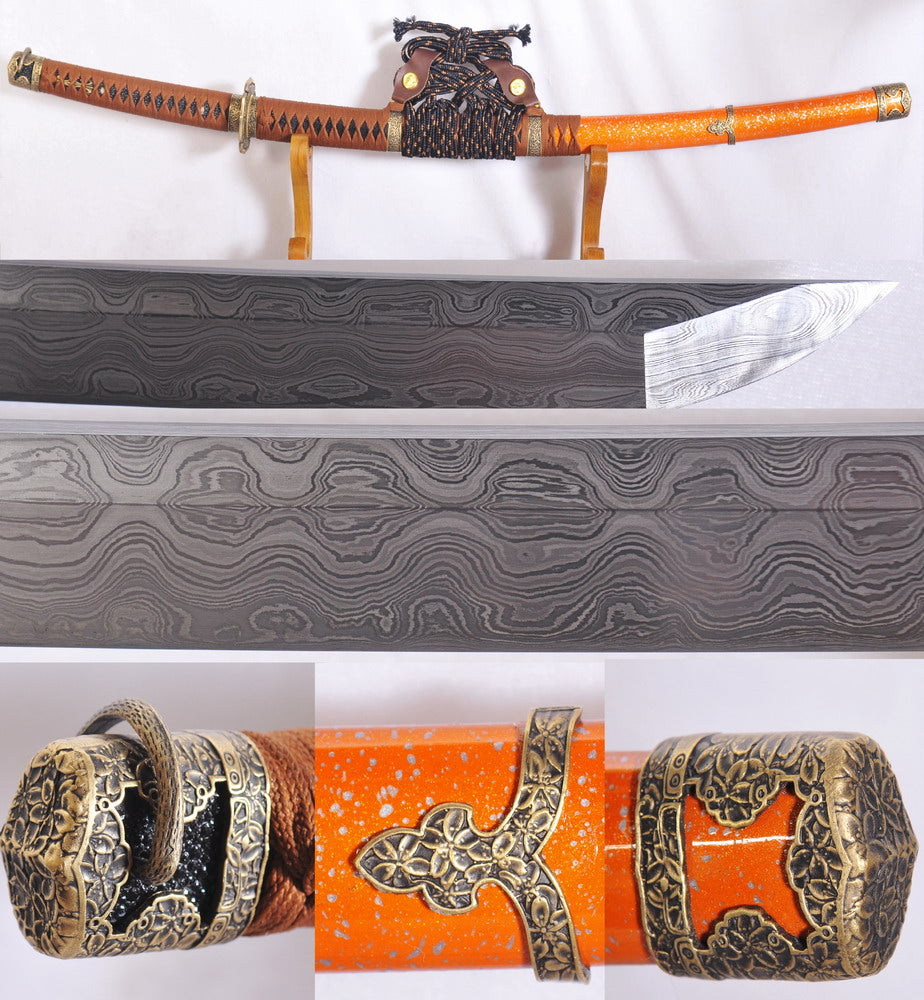
Specifications
| Overall length | 40.9 inch (104 cm) |
| Blade Length | 27.9 inch (71 cm) |
| Weight | 1225.8 g |
| Blade Material | High Grade Damascus Folded Steel |
| Handle Specifications | Silk, Genuine Rayskin, Premium Brass Fittings |
| Usage | Fully functional – Heavy cutting |
| Price | $538.99 |
Pros
- Functional Tachi
- Highly decorative
- Beautiful Damascus pattern blade
Cons
- The blade may tend to dull faster with regular use
Many people often confuse tachi and katana because of their similarities. Many others face this decision when choosing their first samurai sword. Although the tachi was originally a horseback weapon, in modern times, their usage is pretty much the same. So, the decision is based more on personal preferences.
One thing I love about tachis in general is that they feature a more ceremonial-looking appearance. Similarly, the Miyazaki is our pick for the best tachi. It looks like a decorative or ceremonial sword; however, it’s fully functional. Something unique about the Miyazaki is the Damascus pattern that covers the blade.

The steel used to forge the blade is high-grade Damascus folded steel, comparable to 1095 high-carbon steel. It features a typical square tachi tsuba (guard) (Aoi-gata shape) that is gold-colored with dark accents. The handle is wrapped in black rayskin and brown silk ito. The full tang is secured with two mekugi.
It comes with a hardwood tachi saya (also wrapped with the same silk ito) and premium brass fittings. Overall, the sword is very detailed, decorative/functional, and perfect for display, dojo, iaido use, heavy cutting practice, etc.
Best Nodachi: Sasaki Kojiro
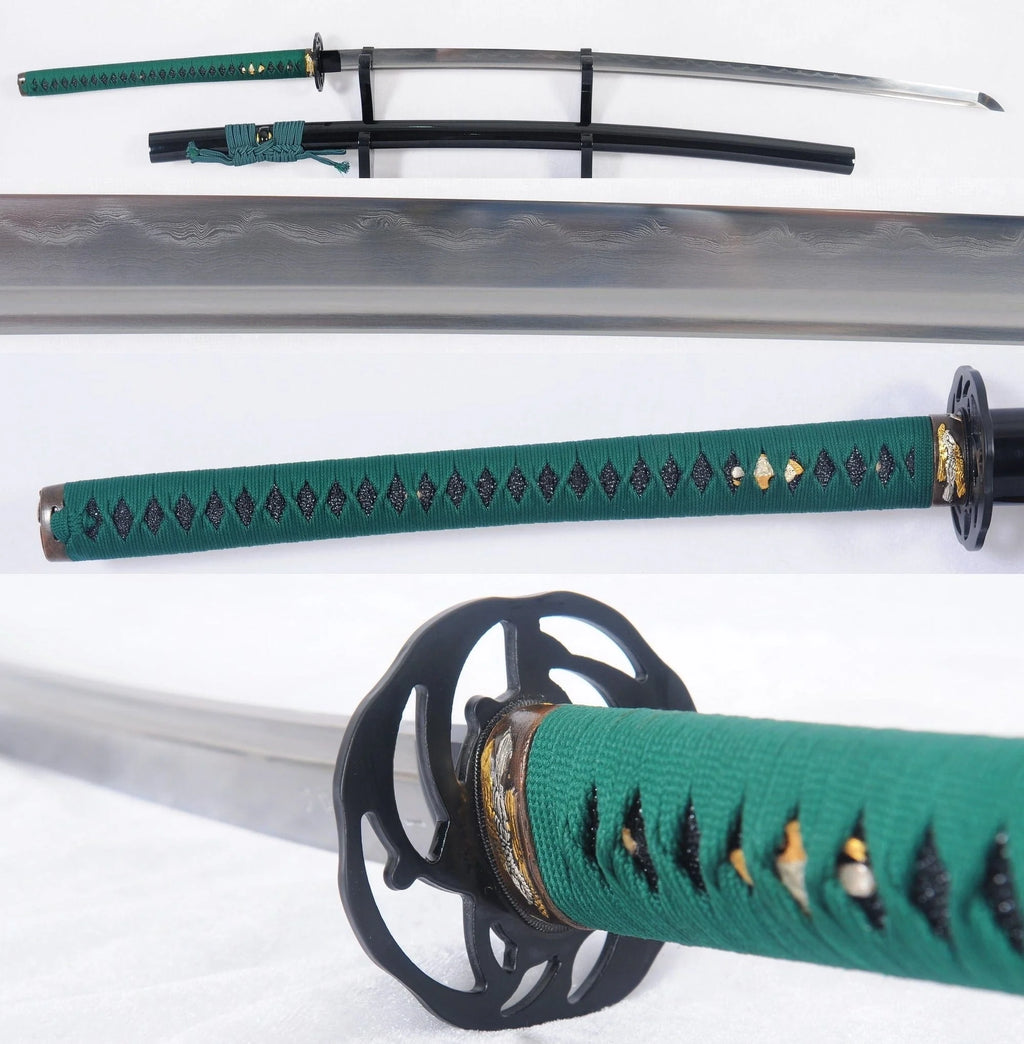
Specifications
| Overall Length | 53.1 inch (135 cm) |
| Blade Length | 35.4 inch (90 cm) |
| Weight | 1 400 g |
| Handle Specifications | Silk, Genuine Rayskin, Premium Iron Fittings |
| Blade Material | 1095 High Carbon Steel |
| Usage | Fully functional |
| Price | $739 |
Pros
- Battle-ready Nodachi
- Great for display
- Offer customization options
Cons
- Heavier than other samurai swords
- Simple tsuba
- Harder to use effectively
Sasaki Kojiro’s is a nodachi (or odachi), one of the largest katanas used in large-scale battles by samurai. One common issue with many modern odachi replicas is that they tend to be too flexible, which generally results in lower cutting performance. For Kojiro, we didn’t find any comments about it being more flexible than it should be.
Personally, I’m a nodachi fan, but I wouldn’t recommend one for enjoyable cutting sessions or iaido use (if you are a beginner). However, as part of a collection or display, they definitely look amazing. Kojiro is inspired by Sasaki Kojiro’s famous Monohoshi Zao Sword, and its length is accurate to his original. The full length is 53.1 inches (135 cm), with the blade alone being 35.4 inches (90 cm).
The blade is forged from 1095 high-carbon steel, clay-tempered and folded, with a polished, mirror-like surface. You can easily see its grain pattern and hamon. Even though samurai odachis are generally heavier, Kojiro is surprisingly light for such a large sword (around 1400 g without the saya).
Its features include silk sageo/ito, genuine same’ (rayskin), premium copper and iron fittings, and a black lacquered hardwood saya. One thing I would like to see is a more elaborate tsuba. Historically, nodachis were more oriented toward functionality than katanas, with fewer details; however, this would have made it more aesthetically appealing.
Read: Nodachi vs Katana
Best Wakizashi: Bessho Nagaharu
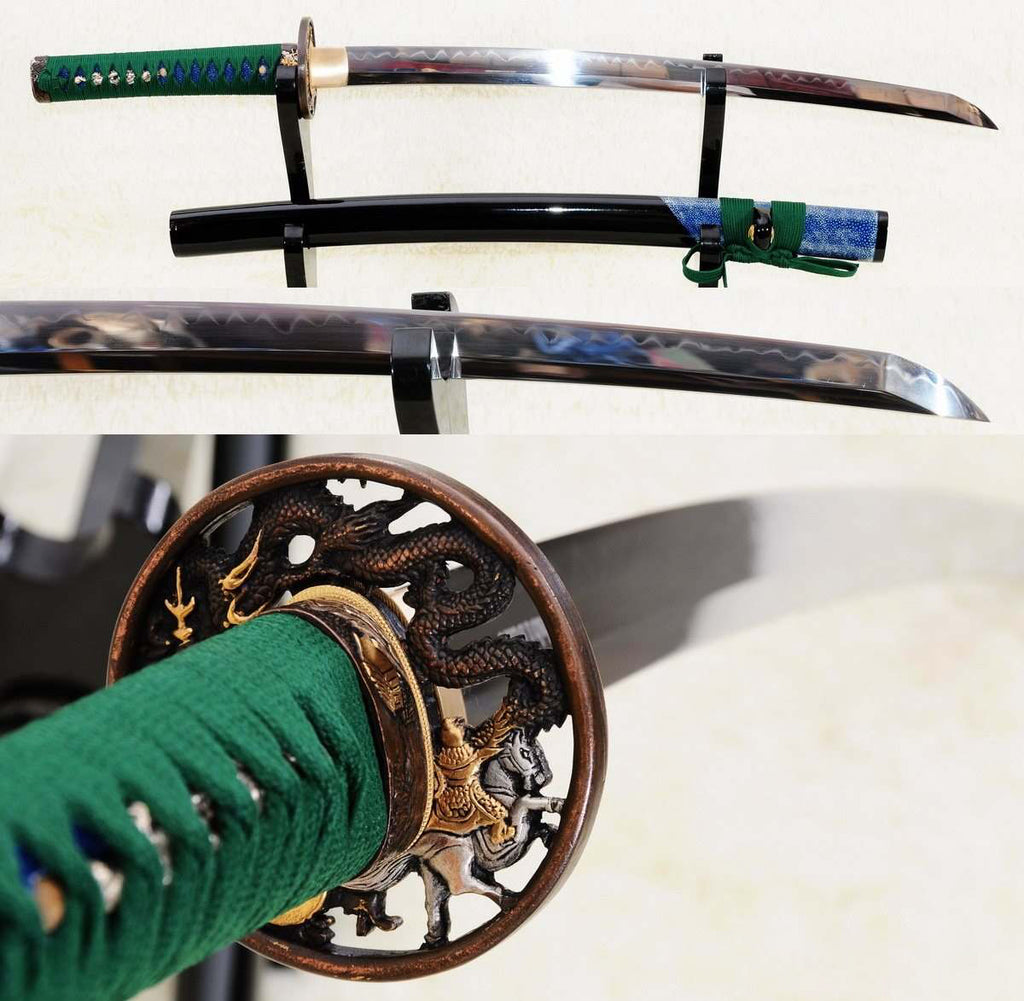
Specifications
| Overall Length | 30.7 inch (78 cm) |
| Blade Length | 19.7 inch (50 cm) |
| Weight | 725 g |
| Handle Specifications | Silk, Genuine Rayskin, Iron Fittings |
| Blade Material | 1095 High Carbon Steel |
| Usage | Fully functional |
| Price | $369 |
Pros
- Easier to use
- Fully functional
- Affortable
- Offers customization options
- Perfect for self-defense or home defense
Cons
- Simple tsuba
Even though the katana is known to be the main samurai sword, they didn’t actually use it much. Instead, the wakizashi was more like a primary tool. It was one-handed, faster, and easier to use. It offers good reach and is perfect in tight spaces and close range. Our search for the best wakizashi led us to Bessho Nagaharu. Like Kojiro, this is a sword crafted in Longquan, a city that has been forging traditional swords for over 2,600 years.
Nagaharu is a traditional design crafted in a wakizashi length following traditional techniques. You will find all the authentic details in it, including a traditional design, natural hamon, securing method (two mekugi pegs), and full tang construction. The guard (tsuba) is made of iron and it’s highly elaborate, while the one-handed handle is wrapped in silk sageo/ito and genuine same’ (rayskin).
Read: Wakizashi vs Katana
Best Tanto: Kurume
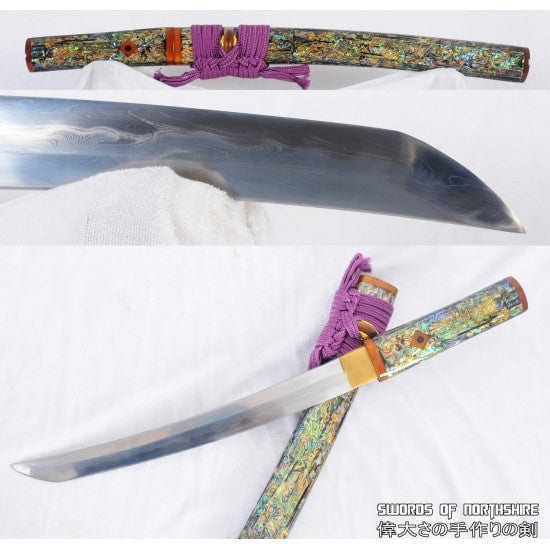
Specifications
| Overall Length | 21.3 inch (54 cm) |
| Blade Length | 12.2 inch (31 cm) |
| Weight | 700 g |
| Handle Specifications | Hardwood, Mother of Pearl, Natural Shells, Buffalo Horn |
| Blade Material | 1060 High Carbon Steel |
| Usage | Fully functional |
| Price | $449 |
Pros
- Unique mother-of-pearl design
- Functional blade
Cons
- It comes only in a shirasaya style of mounting
Tantos are one of the smallest-bladed tools used by samurai, primarily for stabbing in close combat, everyday tasks, self-defense, etc. They were usually companions to katanas and wakizashi (daisho), holding the same value and being equally important. I don’t know if you’re a fan of modern tactical tantos or samurai tantos, but I think Kurume’s blade can perform in both worlds.
Prices in the market vary, as do the materials; however, we made sure to pick the best tanto, whether for a knife collection or usage. Kurume is an authentic samurai tanto crafted with polished mother-of-pearl and natural shells, giving it a beautiful, unique glow of colors. The kashira, fuchi, koiguchi, kurikata, and kojiri are made of polished brown buffalo horn.
The blade is forged using 1060 high-carbon steel with a clearly visible hada that resembles a feather grain pattern. It comes only in a shirasaya style of mounting. Even though it’s a fully functional samurai knife and can be used for self-defense or other tasks, it’s less safe because of the shirasaya.
Of course, you can change it later if you want; however, I wouldn’t suggest using this one for everyday applications. This is more of a unique collector’s item. Its price is around $450, which I think is very good for such a unique design. However, you may spend a little more if you want to add a hand guard (tsuba) and other fittings.
Best Nagamaki: The Nagamaki Sword of Abe Masakatsu
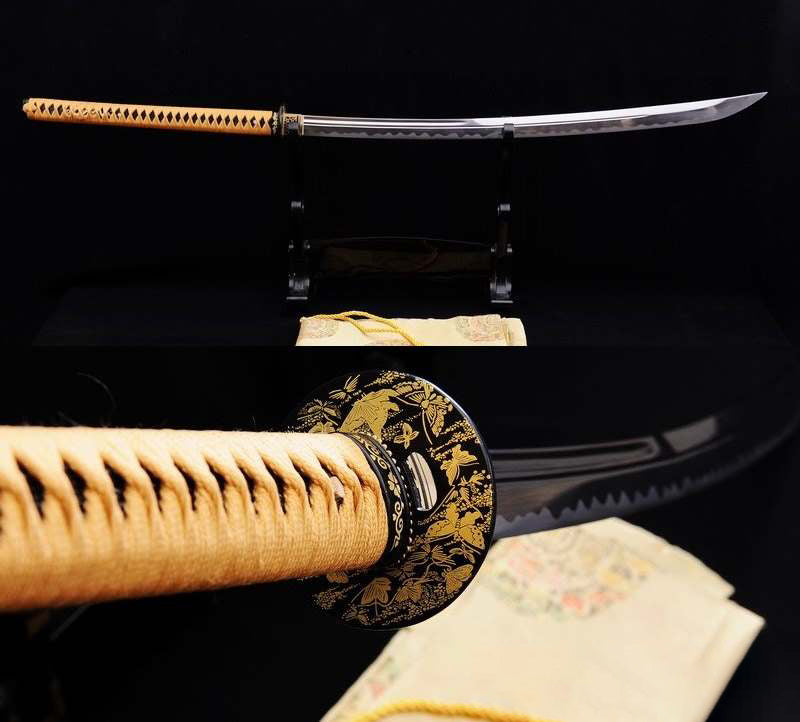
Specifications
| Overall Length | 47.2 inch (120 cm) |
| Blade Length | 27.9 inch (71 cm) |
| Weight | 1400 g |
| Handle Specifications | Rayskin, Silk, Buffalo Horn (Koiguchi), Premium Iron Fittings |
| Blade Material | 1095 High Carbon Steel |
| Usage | Fully functional |
| Price | $479 |
Pros
- Well priced for a nagamaki
- Can cut through hard materials like bone or bambo
- Looks amazing on wall
- The blade geometry is unique
- It feature a clear natural hamon
- Offer customization options
Cons
- Harder to use
Similar to the nodachi, the nagamaki is one of the best samurai swords used on open battlefields and probably the least known. What made this weapon so effective was its unique design with an extra-long handle (almost as long as its blade), which offered many advantages in battle. This nagamaki is crafted by Longquan swordsmiths, featuring a very unique structure.
It’s a mix between a katana and a naginata, but the Unokubi-Zukuri blade shape is a unique addition. It features a blade length of around 27.9 inches (72 cm), with a very clear hamon created from the clay tempering process. The handle length is around 15.7 inches (40 cm) with a full tang construction (it also features a hand-engraved mei) and is secured with two bamboo mekugi.
The sword comes razor-sharp and cuts easily through tatami. After testing, the blade was not damaged or even scratched, David says. It fits tightly into the scabbard and functions very well overall, he adds. Other fittings include a black lacquered hardwood saya, rayskin wrap, buffalo horn koiguchi, silk sageo/ito, genuine same’ (rayskin), and premium iron fittings.
Customize Your Katana
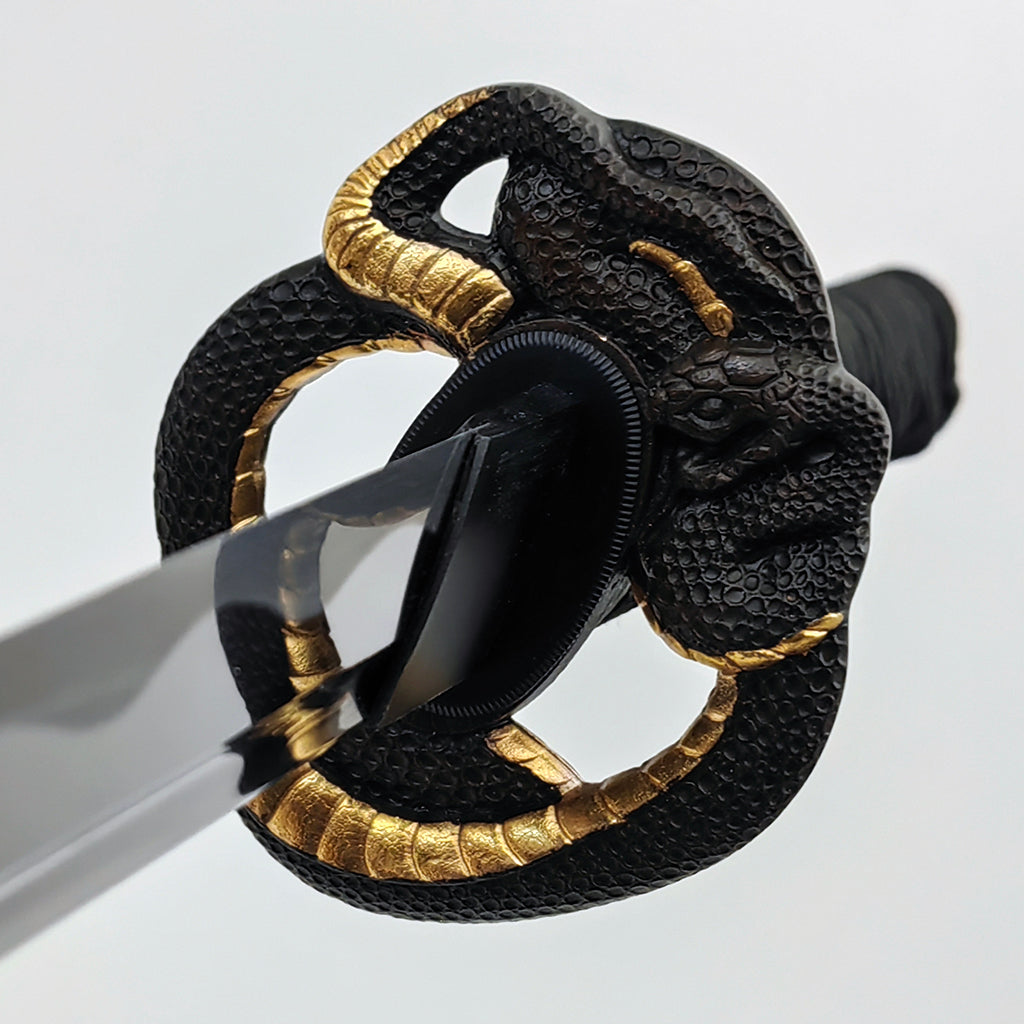
In 2025, custom samurai swords are the most popular among enthusiasts and collectors. Unlike mass-produced blades, a custom katana offers a personalized experience that aligns with your unique needs and preferences. You can choose the length of the blade, the type of steel, style of the handle, different guard designs, colors and even signature engravings.
Except normal high carbon steel used for swords you also can choose the traditional Tamahagane, the same steel Japanese swordsmiths used back at the time. This level of customization will ensure that your hand forged Japanese katana will be unique and tailored to your specific needs and preferences.
You can choose the length of the blade, the type of steel, style of the handle, different guard designs, colors and even signature engravings. Except normal high carbon steel used for swords you also can choose the traditional Tamahagane, the same steel Japanese swordsmiths used back at the time. This level of customization will ensure that your hand forged Japanese katana will be unique and tailored to your specific needs and preferences.
Last Words
If you want to become a samurai, make sure to pick the best samurai sword for yourself. I can’t say which sword they used was the best, but I can say for sure that each was perfect for its role in battle. If you’re purchasing a functional samurai sword, the first things you should pay attention to are the steel type and the tang, as they are crucial for performance and safety.
Also, avoid cutting hard materials that could damage or even break your katana. A great sword will serve you well—but only if you take care of it. Before purchasing, make sure to check local laws regarding the ownership and carrying of swords to ensure compliance with regulations.
FAQ
How much is an authentic samurai sword?
The price of an authentic samurai sword can vary widely depending on its quality, craftsmanship, and historical value. Generally, a genuine, traditionally forged samurai sword starts from around $5,000 and can go up to $50,000 or more for high-quality or antique pieces.
What is a samurai sword called?
Samurai used several types of swords, each with different names and pourposes. The most well-known is the katana. See our Samurai Sword vs Katana to see and learn their similarities and differences.









